Marketing is incomplete without mistakes.
As much as 96.6% of marketers say that they have made a marketing mistake at least once in their career.
New businesses are no different.
In fact, if you just started a business, you are more likely to make marketing mistakes due to inexperience.
One of the best ways to stay away from common mistakes is to learn from other marketers’ mistakes. This is exactly what this actionable guide is about.
It explores the common marketing mistakes new businesses make. You will get to know how you can avoid these mistakes in simple steps.
Common Marketing Mistakes and How to Avoid Them
As a new business owner or founder of a startup, you end up making tons of marketing mistakes. Below is a list of the common marketing mistakes new business owners make and how you can avoid them so you can be at the top of your marketing game:
No Marketing Strategy

Lack of a marketing strategy is one of the major mistakes that new businesses make.
There are multiple reasons why new businesses don’t have a marketing strategy, but two reasons stand out:
- Lack of awareness about the importance of a marketing strategy and what role it plays in marketing success
- Lack of resources to create a strategy such as tools or manpower.
Only 41% of marketers have a documented content marketing strategy and 36% of businesses reported that they have a strategy, but it’s not documented.
Less than half marketers have documented, written marketing strategies.
And that’s the problem.
If you don’t have a strategy, you don’t know what you are supposed to do, how you have to do it, or how to measure its performance.
You can spend money to generate traffic, leads, and sales, but in the absence of a marketing strategy, you’ll end up nowhere.
Consider all your marketing spending wasted if you don’t have a marketing strategy.
How to Fix This Marketing Mistake
Create a marketing strategy, document it, and share it with your team.
A documented marketing strategy gives you direction. It tells you what you are supposed to do and how to do it:
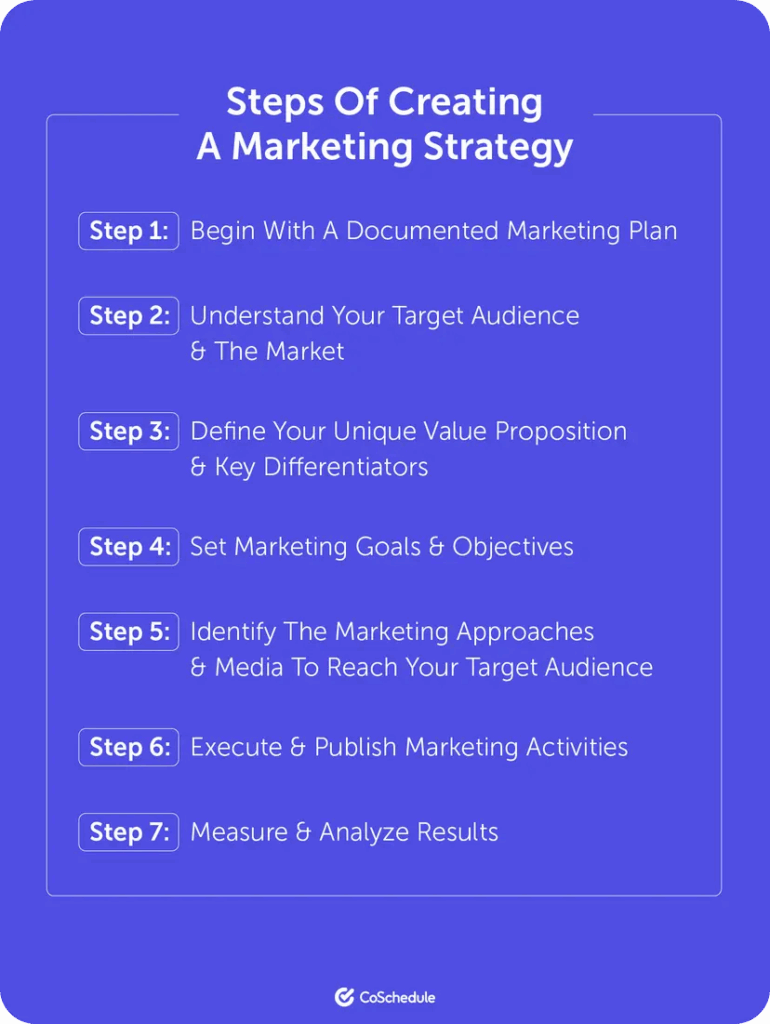
Here’s how to create a marketing strategy for your new business:
- Define purpose using the SMART goals framework by clearly stating your primary marketing goal
- Understand and define your target market and target audience
- Define your unique selling proposition that makes you different than your competitors
- Identify marketing channels
- Define and allocate marketing budget to appropriate channels
- Create content and marketing messaging
- Implement, monitor, and tweak your marketing strategy.
You can use a marketing strategy template online (e.g., HubSpot). It’ll set you on the right track.
The document you create should be shared with the right people so they know what they are supposed to achieve and how.
Regularly tweak your marketing strategy based on its performance and external factors. It’s best to review and update your strategy once every 6 months.
You Don’t Know Your Ideal Customers
You don’t know who your target audience is.
Having a marketing strategy doesn’t mean you know your target audience. You can have an exceptionally well-crafted marketing strategy, and it can fail miserably if you don’t know your target audience.
In such a case, you’ll end up marketing to the wrong people who aren’t interested in your product (for any reason).
Understanding your audience and customers is hard.
Why?
It requires intensive market research, data collection, and data analysis. It all comes with a heavy cost and most businesses aren’t willing to spend resources to build buyer personas.
A buyer persona (is a semi-fictional representation of who your ideal customers are) is the core component that plays an integral part in knowing your customers. It helps you make use of all the data you have and use it precisely in marketing campaigns.
But businesses don’t spend their resources on development on buyer personas.
Part of the problem is that buyer personas aren’t directly linked to revenue. When businesses don’t see a tangible, quantitative outcome of an activity, they abandon it.
Lack of buyer personas and not knowing your ideal customers lead to irreversible damage to your marketing strategy.
Around 71% of high performing companies use buyer personas and these businesses are 7x more likely to update their personas regularly:
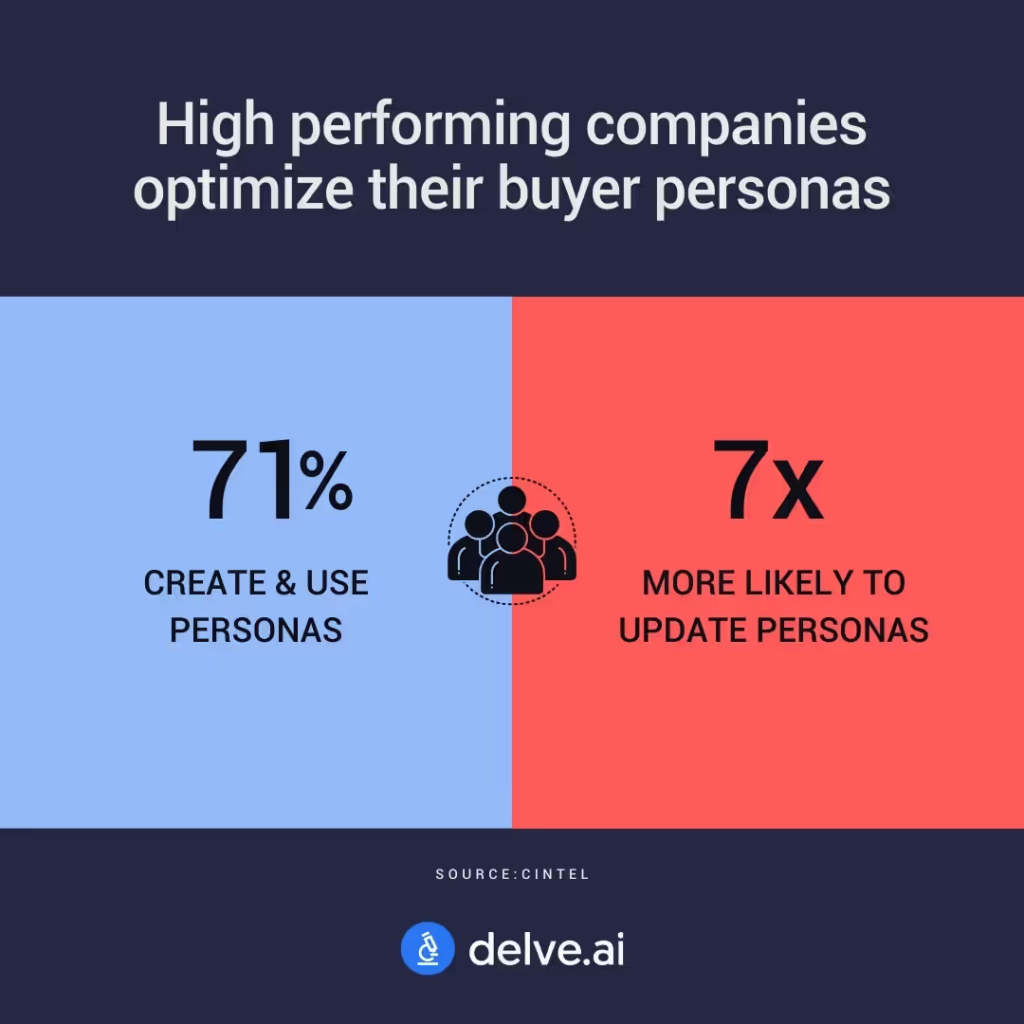
You can’t be an effective marketer if you don’t have buyer personas.
How to Fix This Marketing Mistake
The best way to understand your customers and audience is to create buyer personas.
Here’s what a buyer persona looks like:

Developing a buyer persona needs data collection from your audience and then adding all the data to the personas. This allows you to use customer personas in marketing campaigns (for targeting).
Follow these steps to create accurate, data-driven buyer personas for your business and avoid this lethal marketing mistake:
- Start collecting data about your customers. This includes primary and secondary data from sources such as analytics, surveys, competitors, etc.
- Segment your customers based on key variables
- Add data to buyer persona templates. Use free templates available online, or create your own with all the necessary details about each persona
- A single buyer persona should represent a customer segment
- Refine, tweak, and improve buyer personas as you get more data.
The route to understanding your audience goes via buyer personas. There’s no other way.
Refer to this detailed guide for more details.
Improper Research
Research includes market research, keyword research, competitor research, and any other form of research that is directly or indirectly linked with marketing.
Not only do a good chunk of new businesses end up underestimating the value of research, but they also don’t do it correctly (even if they decide to give it a shot).
Bloggers who research keywords before writing a new post are more likely to be successful than those who don’t. In another study, 45% of marketers said that researching and adding new keywords to their blog and content they write significantly improves rankings:

Keyword research is just one form of research that’s used in marketing. Other forms of research include:
- Data collection and analysis for personalization and targeting
- Competitor analysis to find out what your competitors are doing
- Understanding analytics and using it for decision-making
- Experimentation for conversion rate optimization.
In the absence of proper research, you end up making decisions based on your judgment or a guess. For instance, when writing a new blog post for your business blog, you pick any topic and write cover it without knowing if this is really what your audience is actively searching for.
Or, you end up choosing a social media network to run ads based on your best guess instead of looking at existing data or collecting primary data from your ideal customers.
How to Fix This Marketing Mistake
Spend resources on research and the right tools.
Whether it’s keyword research or primary data collection for buyer personas, you need to spend ample resources to do it correctly.
You need to get the right tools to do it. Research shows that up to 78% of marketing professionals use keyword research tools when they are working on content:
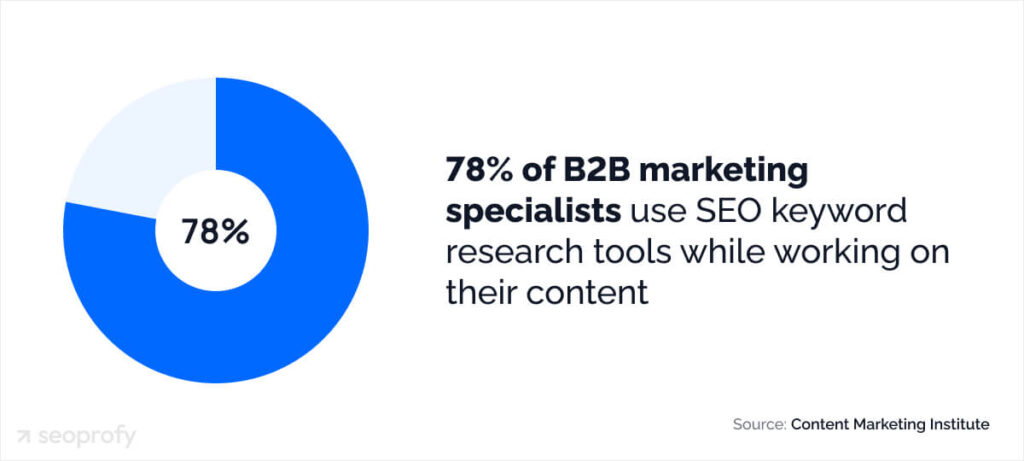
So, you need to develop and nurture the right mindset and acquire the tools to conduct market research appropriately to guide marketing decisions.
Follow these best practices to improve your research skills for marketing:
- Avoid guesswork for marketing. Make decisions based on data
- Build the right tech stack for your business
- Find and target the right keywords for content
- Use competitor spying tools to find what keywords your competitors are bidding for in search ads
- Run surveys and interviews to collect data from your customers whenever possible
- Collect feedback from website visitors regularly
- Use Google Analytics to collect and analyze website data.
Using Wrong Marketing Channels
While it seems to be a great idea to use several marketing channels and touchpoints to reach your audience, doing so without homework often backfires.
A marketing channel refers to a platform or touchpoint you use to reach your target audience. For instance, Google, Facebook, LinkedIn, and Quora are four different marketing channels:
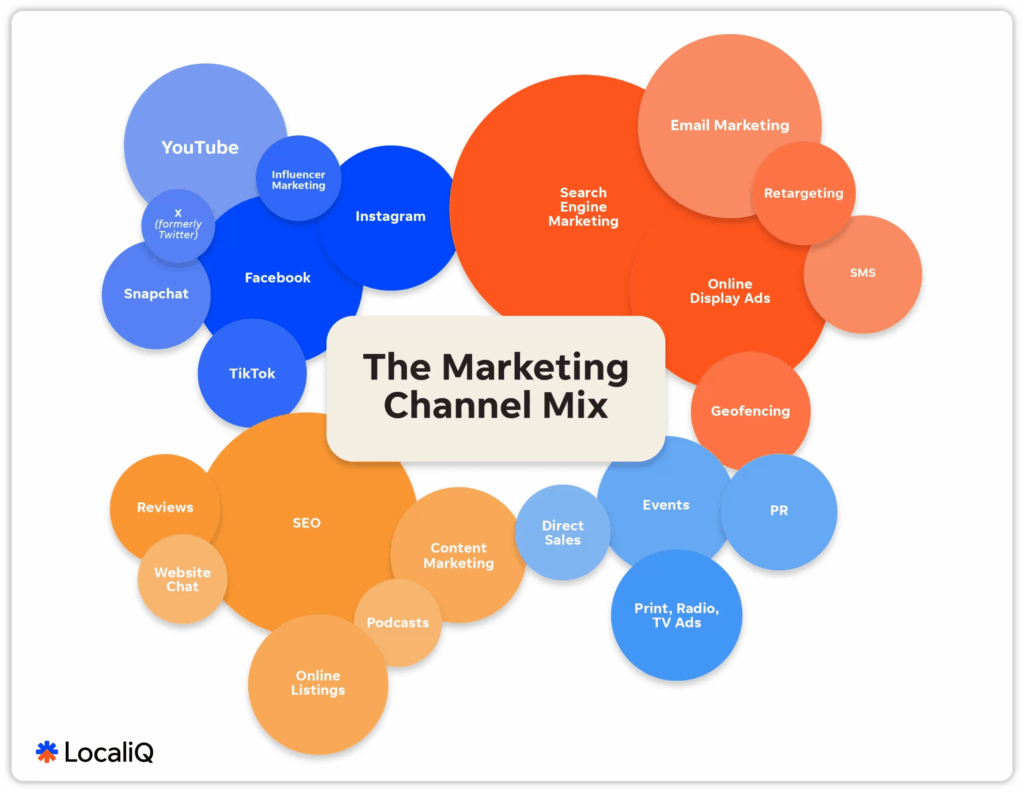
The list of such marketing channels is pretty long and it keeps on expanding as new channels are added to it based on popularity and user base of the platforms.
If you use TikTok, just because it’s a popular social media platform among Gen Z and it is the platform where they find and buy products, without looking at the dynamics of your product and audience, you’ll end up losing money.
Just because a marketing channel is popular, trending, or used by millions – doesn’t mean you have to use it.
Most new businesses suffer from what we call shiny object syndrome. They want to try new, flashy, and shiny touchpoints to connect with their audience without realizing if their ideal customers are really using that channel.
How to Fix This Marketing Mistake
Don’t get distracted. Stay focused. And stick with your marketing strategy.
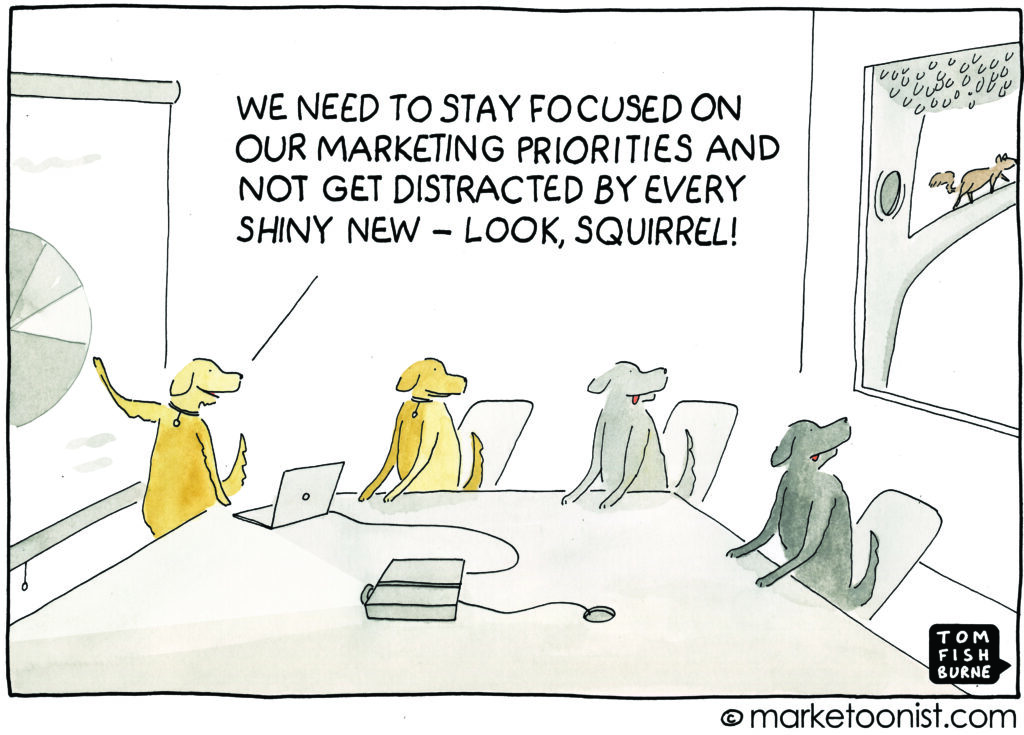
You need to ask yourself the following two questions when selecting a marketing channel:
- Does this marketing channel align with your marketing strategy?
- Does your target audience use this touchpoint?
The best way is to look at your buyer personas. If you don’t have information about a channel in your customer personas, get it updated.
A simple survey, a feedback form on your website, or interview calls with a few customers will help you find exact information about a potential marketing channel.
Ask your existing customers if they are using a channel, if yes, how often, and why?
Add the same data to buyer personas and then decide if a marketing channel is worth investing in.
It’s not bad to target multiple marketing channels simultaneously via different campaigns. You should do it. All businesses do it.
How you pick and choose marketing channels is what’s important.
Lack of Optimization
I am a big fan of conversion rate optimization (CRO). It’s because it plays a massive role in marketing, ROI, CAC, and CLV. You can’t do good without it.
Unfortunately, CRO is the last option for most businesses.
For most, it’s not even part of their marketing strategy.
Up to 68% of small businesses don’t have a CRO strategy, 82% marketers agree that it’s very challenging to track and test conversion rates, and 40% of businesses have no one responsible and accountable for conversion rate optimization.
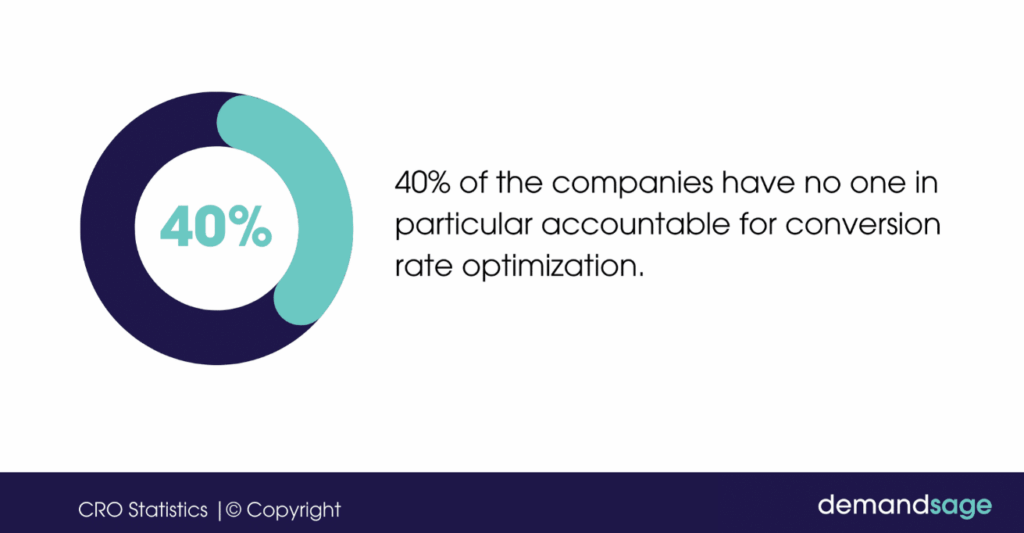
Lack of optimization negatively impacts leads, sales, customer acquisition cost, revenue, and customer lifetime value. Not optimizing campaigns for conversion rate means your marketing budget is underutilized.
There’s always room for improvement.
You can earn more with the same marketing budget by optimizing your campaigns. Not doing so is a lethal marketing mistake.
How to Fix This Marketing Mistake
Develop a conversion rate optimization mindset and strategy.
The first step is understanding the importance of CRO and how it impacts marketing cost and revenue. This is more of a mindset and business culture thing. You need to first understand its importance and then develop an organizational culture where your team takes it seriously.
Here’s a simple example of how CRO directly impacts revenue:
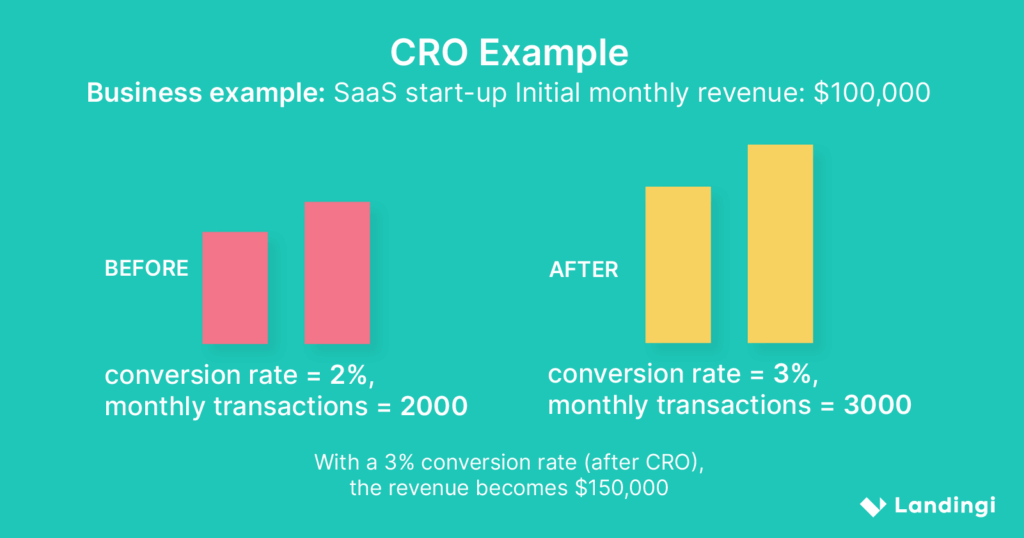
A mere 1% increase in conversion rate can do wonders.
For instance, you have a marketing budget of $1,000. The average conversion rate for all the campaigns is 4% which means you generate 40 leads or sales after spending $1,000.
Let’s assume you track a sale as a conversion and a single sale has a value of $50.
This comes down to $2,000 in sales with 40 conversions at 4% conversion rate with a budget of $1,000.
If you increase the conversion rate by 1%, you now have a 5% conversion rate and the same marketing budget. You now generate 50 conversions and total revenue jumps to $2,500.
You are now making an additional $500 with the same marketing budget. And that’s just 1% increase in conversion rate.
Once you understand how important CRO is for your business, you need to develop and implement a CRO strategy. Here’s how to develop your CRO strategy:
- Define SOPs and guidelines
- Create a CRO team
- Allocate budget and provide resources to the CRO team
- Audit and analyze all the marketing campaigns
- Identify areas of improvement and develop data-driven hypotheses
- Test hypotheses using a CRO tool
- Implement changes
- Repeat.
Poor Attribution
Marketing attribution refers to the process of assigning a specific value to marketing touchpoints or channels. This helps in understanding and measuring the contribution of individual marketing channels to sales or conversions.
It helps you quantify the influence of marketing channels that led to a sale.
It’s an ignored area and minimal businesses track attribution. The top 3 reasons for not using marketing attribution include a lack of understanding, unavailability of resources, and complex customer journeys:
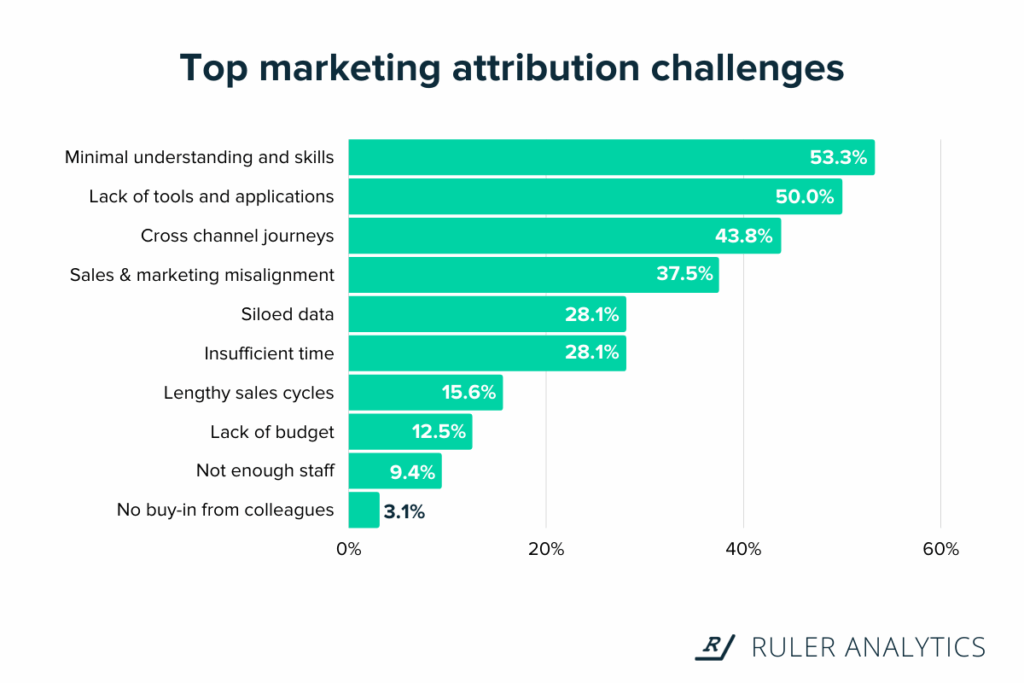
An average customer interacts with your business across multiple channels before conversion. The journey isn’t always a straight line and this is a major reason why most businesses ignore attribution:
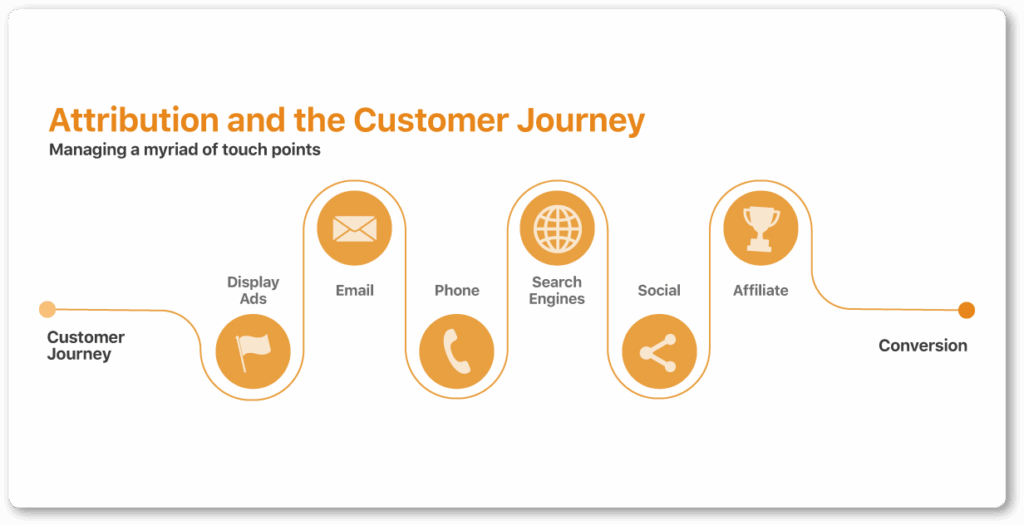
On top of that, assigning a value to every channel is quite complicated. It’s hard to figure out the real value of all the touchpoints. You know the total value of a sale, but distributing it across channels isn’t a straightforward process:

Consequently, small businesses abandon marketing attribution and don’t track it altogether.
Downside?
You then never get to know what marketing channels are contributing to sales. This leads to improper budget allocation and you might end up spending on touchpoints that don’t contribute to sales.
The worst part?
Businesses keep doing it forever.
How to Fix This Marketing Mistake
Set up marketing attribution.
You can do it free of cost in Google Analytics. You can choose from three models it uses:
- Data-driven attribution
- Paid and organic last click
- Google paid channels last click.
It’s best for your business if you are using Google Ads.
Alternatively, you can use a dedicated attribution modeling tool like Ruler Analytics or a simpler one like HubSpot.
The idea is to understand your customer journey as early as possible so you can optimize it. Instead of spending money on touchpoints blindly, you need to use data to find the top ones so you can channelize your marketing budget.
It’ll give you a competitive advantage over your competitors. Most businesses don’t spend money on attribution and thus fail to optimize their marketing budget.
You can outperform them by setting it up for your business.
Not Giving Time
Marketing isn’t a silver bullet. It needs time and patience.
Even if it’s paid ads, you won’t be able to get a decent ROI instantly. Sure, you get traffic and conversions, but it takes a lot of time and experimentation to make your campaigns profitable.
It takes, on average, 1-3 months for a paid ad campaign to deliver positive ROI.
If you are lucky, you might see positive results quickly, but it rarely happens.
Organic traffic, on the other extreme, takes much longer. It takes an average of 2 years for a blog post to deliver results in terms of organic traffic and ranking:
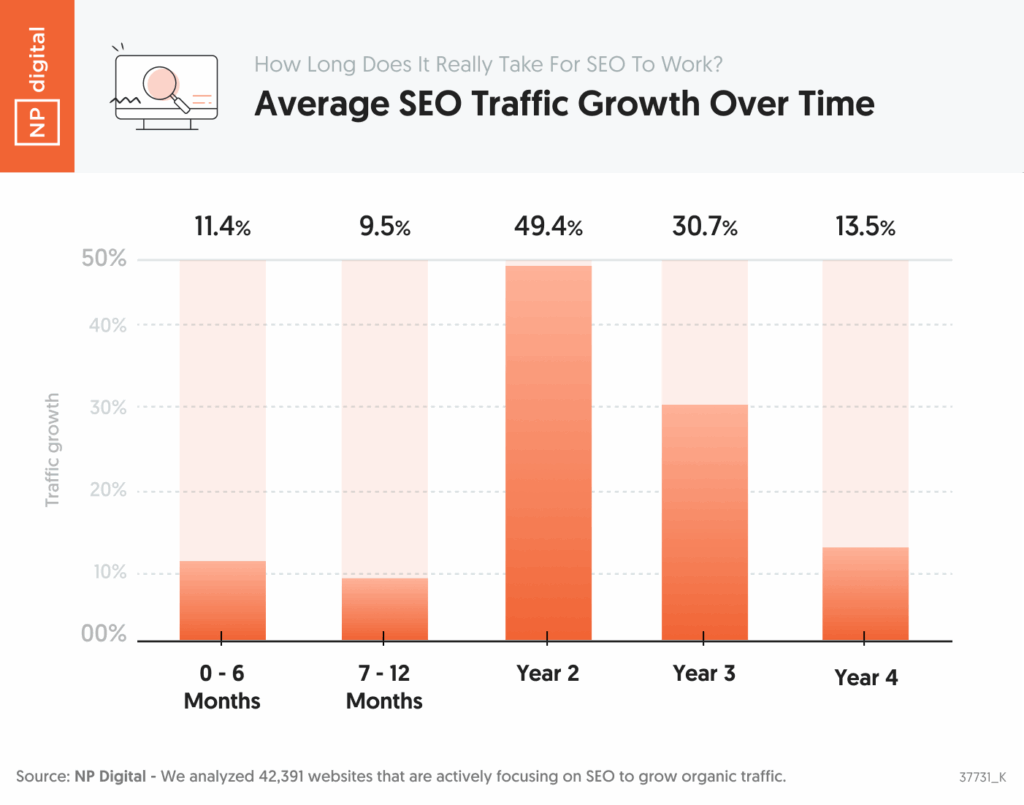
Digital marketing, or any form of marketing, needs time.
Businesses need results fast. They need success overnight.
Take paid ads as an example.
The number one reason why businesses run ads is to drive instant traffic to a landing page so they can generate sales. It does happen, but it takes a lot of time to optimize campaigns and to make them profitable.
How to Fix This Marketing Mistake
Be patient and give marketing campaigns ample time.
The idea is to monitor your campaigns and optimize them to improve performance. Give time to marketing campaigns as algorithms need time to learn and auto-optimize your ads.
When investing in organic traffic, be clear on its time commitment, as it needs 2 years to show results. This means the content you are publishing today on your blog will reach its full potential in the next 2 years.
Be mentally prepared when investing in any form of marketing.
Follow these guidelines to prepare yourself for the long haul:
- Be ready for a long-term commitment and don’t expect results overnight
- Allocate marketing budget smartly and diversify it
- If things aren’t working as expected, don’t lose hope. Tweak and improve
- The initial days of any new campaign are challenging. You might not see any traction and the ROI will be negative. Don’t stop/pause your campaign, rather stick with it
- Invest more in sustainable, long-term marketing campaigns like inbound marketing.
Lack of Marketing Personalization
Customers need personalized and customized marketing content and ads. As much as 90% of marketers say that marketing personalization significantly increases profitability.

Yet, 63% of digital marketers reported that they struggle with marketing personalization, according to Gartner.
There are numerous challenges that new businesses face with personalization:
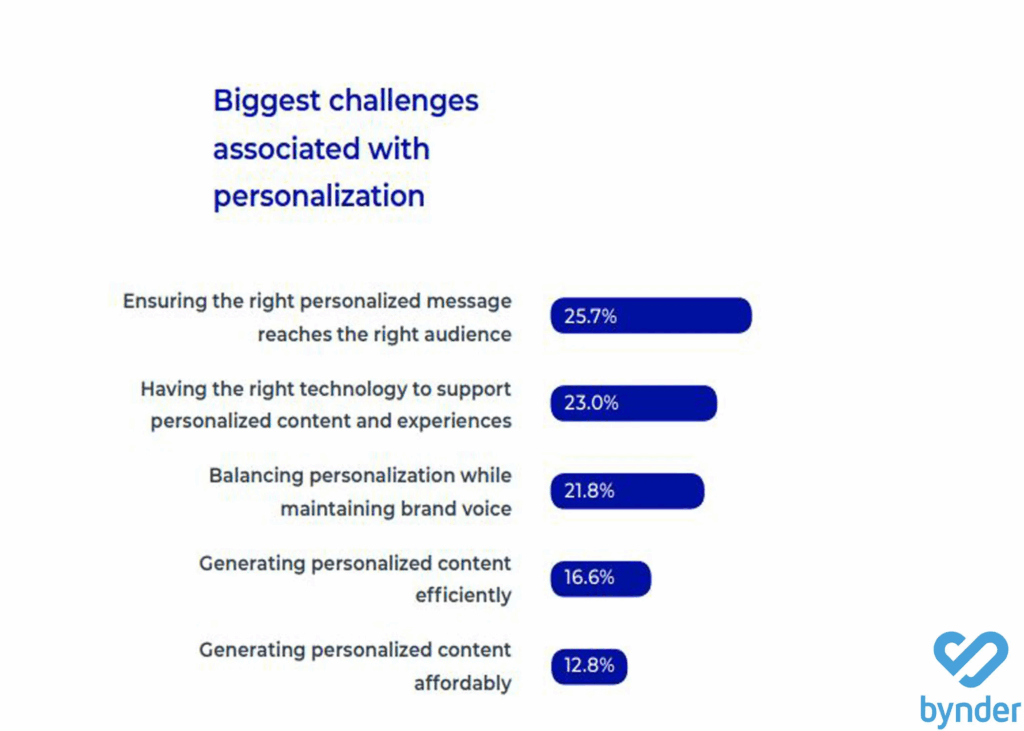
- Messaging issues
- Not having the right technology
- Personalized content generation
- Affordability.
These challenges restrict new businesses from offering marketing personalization at scale.
How to Fix This Marketing Mistake
Personalization is driven by customer data.
The only solution to customized marketing that your audience loves is to start collecting, analyzing, and using customer data. You need a CRM tool or a customer data management (CDM) platform.
Collect first-party data via your CRM platform, buyer personas, and analytic tool, and use it for personalized marketing. You need behavioral data and demographics to get started.
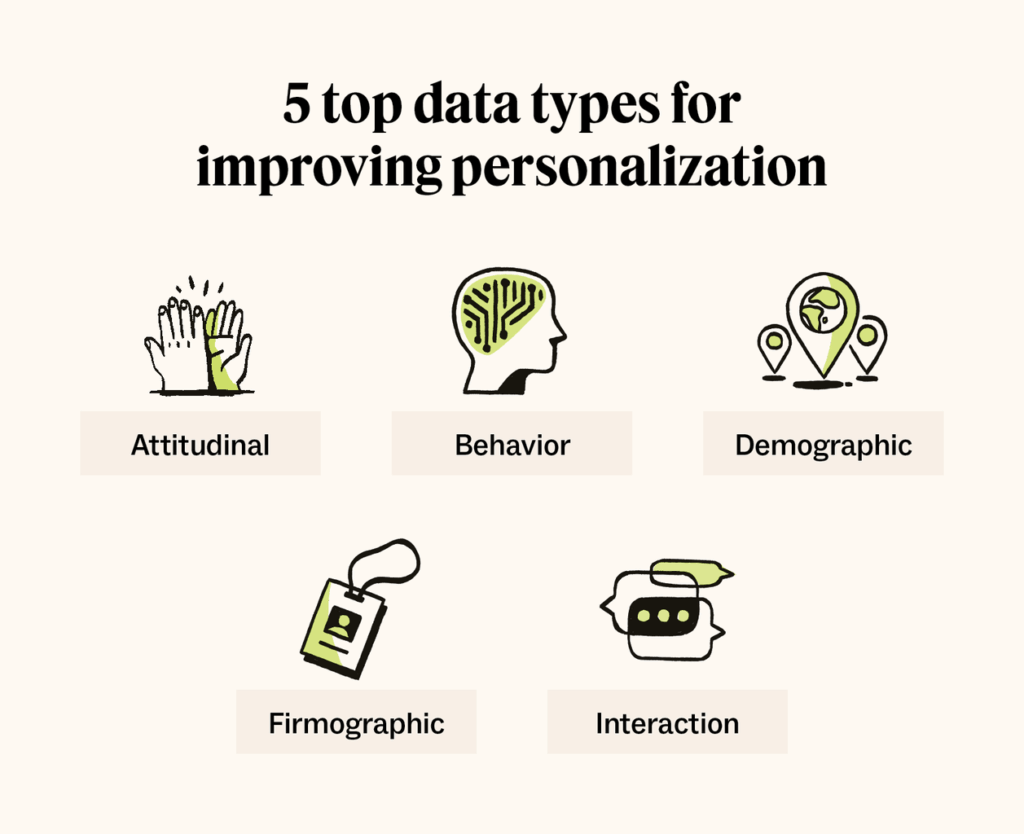
You need to customize marketing collateral which mostly includes content across your channels based on data. For instance, you can use dynamic content on landing pages to align offers with visitors’ previous engagement with your business.
You can take marketing personalization one step further by optimizing and customizing the entire customer journey. This is where you’ll need a CDM platform and integration.
Follow these tips to implement marketing personalization:
- Collect lots of data. The more data you have, the better
- Segment customers based on key variables
- Use location-based marketing campaigns to reach people in a specific location
- Leverage dynamic content
- Use email marketing personalization to boost engagement and reorder value.
Final Thoughts
Marketing mistakes aren’t dangerous. Businesses and marketers make mistakes all the time. Smart business owners and marketers, however, have two things in common.
First, they learn from their own mistakes and use every mistake as a step towards success.
Second, they learn from other people’s mistakes and avoid making them in the first place.
Use marketing mistakes in this guide as a source of learning. Avoid these and get better at marketing.
Featured Image: Pexels



